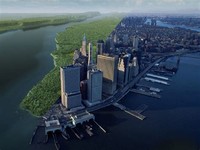Facts about Manhattan

Manhattan is a borough of New York City, New York, USA, coterminous with New York County.

Manhattan has the largest central business district in the United States.

The name Manhattan derives from the word Manna-hata, as written in the 1609 logbook of Robert Juet, an officer on Henry Hudson's yacht Halve Maen (Half Moon).

In 1625, Manhattan Island was chosen as the site of Fort Amsterdam, a citadel for the protection of the new arrivals; establishment is recognized as the birth date of New York City.

In 1776, shortly after the Continental Army evacuated Manhattan and left it to the British, a massive fire broke out, destroying one-third of the city and some 500 houses.

Today, Manhattan offers a wide array of public and private housing options.

Lower Manhattan is home to both the New York Stock Exchange and NASDAQ and is the nation's third-largest central business district (after Chicago's Loop).

The City of Greater New York was formed in 1898, with Manhattan and the Bronx, though still one county, established as two separate boroughs.

A commercial, financial, and cultural center of the city, Manhattan has many famous landmarks, tourist attractions, museums, and universities.

The Island of Manhattan is the largest section of the borough, which also includes several smaller islands and a small section of the mainland adjacent to The Bronx.

Seven of the world's top eight global advertising agency networks are headquartered in Manhattan.

Only 20.3 percent of Manhattan residents lived in owner-occupied housing, the second-lowest rate of all counties in the nation, behind The Bronx.

In 1951, the United Nations relocated from its first headquarters in Queens to the East Side of Manhattan.

The Continental Army was forced to abandon Manhattan after the disastrous Battle of Fort Washington on November 16, 1776.

In 1626, Peter Minuit acquired Manhattan from native people in exchange for trade goods, often said to be worth $24.

The mayor's staff and 13 municipal agencies are located in the nearby Manhattan Municipal Building, completed in 1916, which was then known as one of the largest governmental buildings in the world.

Manhattan is the economic engine of New York City, with its 2.3 million workers drawn from the entire New York metropolitan area, accounting for almost ? of all jobs in New York City.

The centralized New York City government is responsible for public education, correctional institutions, libraries, public safety, recreational facilities, sanitation, water supply, and welfare services in Manhattan.

Historically, this corporate presence has been complemented by many independent retailers, though a recent influx of national chain stores has caused many to lament the creeping homogenization of Manhattan.

New York City is home to the most corporate headquarters of any city in the nation, the overwhelming majority based in Manhattan.

The rise of immigration near the turn of the century left major portions of Manhattan, especially the Lower East Side, densely packed with recent arrivals, crammed into unhealthy and unsanitary housing.

Lucky Luciano established La Cosa Nostra in Manhattan, forming alliances with other criminal enterprises, including the Jewish mob, led by Meyer Lansky, the leading Jewish gangster of that period.

Midtown Manhattan is the largest central business district in the United States.

British occupation lasted until November 25, 1783, when George Washington returned to Manhattan, as the last British forces left the city.

Manhattan was at the heart of the New York Campaign, a series of major battles in the early American Revolutionary War.

Manhattan has ten City Council members, the third largest contingent among the five boroughs.

The 1980s also saw Manhattan at the heart of the AIDS crisis, with Greenwich Village at its epicenter.

Hudson discovered Manhattan Island on September 11, 1609 and continued up the river that bears his name until he arrived at the site of present day Albany.

Manhattan was greatly damaged by the Great Fire of New York during the British military rule that followed.

The rise of immigration near the turn of the century left major portions of Manhattan, especially the Lower East Side, densely packed with recent arrivals, crammed into unhealthy and unsanitary housing.
Manhattan Island. Manhattan Island is loosely divided into Downtown (Lower Manhattan), Midtown (Midtown Manhattan), and Uptown (Upper Manhattan), with Fifth Avenue dividing Manhattan's east and west sides. ... To the north, the Harlem River divides Manhattan Island from the Bronx and the mainland United States.
